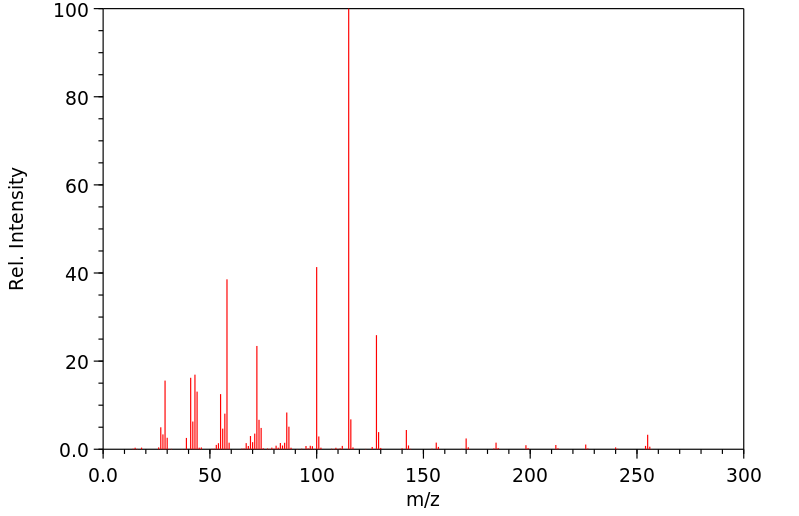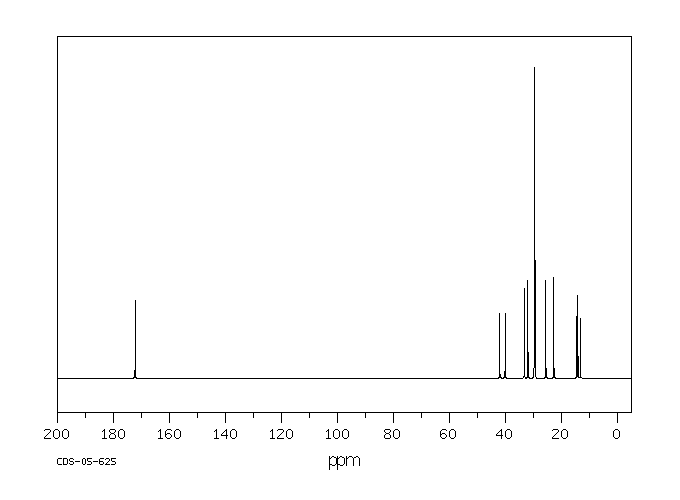N,N-二乙基十二酰胺 | 3352-87-2
中文名称
N,N-二乙基十二酰胺
中文别名
N,N-二乙基月桂酰胺;N,N-二乙基十二胺;DEDOA
英文名称
N,N-diethyldodecanamide
英文别名
N,N-Diethyldodecanamid
CAS
3352-87-2
化学式
C16H33NO
mdl
MFCD00008962
分子量
255.444
InChiKey
CWNSVVHTTQBGQB-UHFFFAOYSA-N
BEILSTEIN
——
EINECS
——
-
物化性质
-
计算性质
-
ADMET
-
安全信息
-
SDS
-
制备方法与用途
-
上下游信息
-
文献信息
-
表征谱图
-
同类化合物
-
相关功能分类
-
相关结构分类
物化性质
-
熔点:3-5°C
-
沸点:166-167 °C2 mm Hg(lit.)
-
密度:0.847 g/mL at 25 °C(lit.)
-
闪点:>230 °F
-
稳定性/保质期:
在常温常压下,该物质是稳定的。
计算性质
-
辛醇/水分配系数(LogP):5.6
-
重原子数:18
-
可旋转键数:12
-
环数:0.0
-
sp3杂化的碳原子比例:0.937
-
拓扑面积:20.3
-
氢给体数:0
-
氢受体数:1
安全信息
-
TSCA:Yes
-
危险品标志:Xi
-
安全说明:S24/25,S26,S37/39
-
危险类别码:R36/37/38
-
WGK Germany:2
-
海关编码:2924199090
-
RTECS号:RB4200000
-
储存条件:常温、避光、通风干燥处,密封保存。
SDS
模块 1. 化学品
1.1 产品标识符
: N,N-DiethyldodECanamide
产品名称
1.2 鉴别的其他方法
无数据资料
1.3 有关的确定了的物质或混合物的用途和建议不适合的用途
仅用于研发。不作为药品、家庭或其它用途。
模块 2. 危险性概述
2.1 GHS-分类
急性毒性, 经口 (类别 5)
皮肤刺激 (类别 2)
眼睛刺激 (类别 2A)
特异性靶器官系统毒性(一次接触) (类别 3)
2.2 GHS 标记要素,包括预防性的陈述
象形图
警示词 警告
危险申明
H303 吞咽可能有害。
H315 造成皮肤刺激。
H319 造成严重眼刺激。
H335 可能引起呼吸道刺激。
警告申明
预防措施
P261 避免吸入粉尘/烟/气体/烟雾/蒸气/喷雾.
P264 操作后彻底清洁皮肤。
P271 只能在室外或通风良好之处使用。
P280 穿戴防护手套/ 眼保护罩/ 面部保护罩。
事故响应
P302 + P352 如果皮肤接触:用大量肥皂和水清洗。
P304 + P340 如吸入: 将患者移到新鲜空气处休息,并保持呼吸舒畅的姿势。
P305 + P351 + P338 如与眼睛接触,用水缓慢温和地冲洗几分钟。如戴隐形眼镜并可方便地取
出,取出隐形眼镜,然后继续冲洗.
P312 如感觉不适,呼救中毒控制中心或医生.
P321 具体处置(见本标签上提供的急救指导)。
P332 + P313 如觉皮肤刺激:求医/就诊。
P337 + P313 如仍觉眼睛刺激:求医/就诊。
P362 脱掉沾污的衣服,清洗后方可再用。
安全储存
P403 + P233 存放于通风良的地方。 保持容器密闭。
P405 存放处须加锁。
废弃处置
P501 将内容物/ 容器处理到得到批准的废物处理厂。
2.3 其它危害物 - 无
模块 3. 成分/组成信息
3.1 物 质
: C16H33NO
分子式
: 255.44 g/mol
分子量
组分 浓度或浓度范围
N,N-DiethyldodECanamide
-
化学文摘登记号(CAS 3352-87-2
No.) 222-118-3
EC-编号
模块 4. 急救措施
4.1 必要的急救措施描述
一般的建议
请教医生。 向到现场的医生出示此安全技术说明书。
吸入
如果吸入,请将患者移到新鲜空气处。 如呼吸停止,进行人工呼吸。 请教医生。
皮肤接触
用肥皂和大量的水冲洗。 请教医生。
眼睛接触
用大量水彻底冲洗至少15分钟并请教医生。
食入
切勿给失去知觉者通过口喂任何东西。 用水漱口。 请教医生。
4.2 主要症状和影响,急性和迟发效应
据我们所知,此化学,物理和毒性性质尚未经完整的研究。
4.3 及时的医疗处理和所需的特殊处理的说明和指示
无数据资料
模块 5. 消防措施
5.1 灭火介质
灭火方法及灭火剂
用水雾,抗乙醇泡沫,干粉或二氧化碳灭火。
5.2 源于此物质或混合物的特别的危害
碳氧化物, 氮氧化物
5.3 给消防员的建议
如必要的话,戴自给式呼吸器去救火。
5.4 进一步信息
无数据资料
模块 6. 泄露应急处理
6.1 作业人员防护措施、防护装备和应急处置程序
使用个人防护用品。 避免吸入蒸气、烟雾或气体。 保证充分的通风。 人员疏散到安全区域。
6.2 环境保护措施
不要让产品进入下水道。
6.3 泄漏化学品的收容、清除方法及所使用的处置材料
用惰性吸附材料吸收并当作危险废物处理。 放入合适的封闭的容器中待处理。
6.4 参考其他部分
丢弃处理请参阅第13节。
模块 7. 操作处置与储存
7.1 安全操作的注意事项
避免接触皮肤和眼睛。 避免吸入蒸气和烟雾。
一般性的防火保护措施。
7.2 安全储存的条件,包括任何不兼容性
贮存在阴凉处。 使容器保持密闭,储存在干燥通风处。
打开了的容器必须仔细重新封口并保持竖放位置以防止泄漏。
7.3 特定用途
无数据资料
模块 8. 接触控制和个体防护
8.1 容许浓度
最高容许浓度
没有已知的国家规定的暴露极限。
8.2 暴露控制
适当的技术控制
根据良好的工业卫生和安全规范进行操作。 休息前和工作结束时洗手。
个体防护设备
眼/面保护
带有防护边罩的安全眼镜符合 EN166要求请使用经官方标准如NIOSH (美国) 或 EN 166(欧盟)
检测与批准的设备防护眼部。
皮肤保护
戴手套取 手套在使用前必须受检查。
请使用合适的方法脱除手套(不要接触手套外部表面),避免任何皮肤部位接触此产品.
使用后请将被污染过的手套根据相关法律法规和有效的实验室规章程序谨慎处理. 请清洗并吹干双手
所选择的保护手套必须符合EU的89/686/EEC规定和从它衍生出来的EN 376标准。
身体保护
防渗透的衣服, 防护设备的类型必须根据特定工作场所中的危险物的浓度和数量来选择。
呼吸系统防护
如危险性评测显示需要使用空气净化的防毒面具,请使用全面罩式多功能防毒面具(US)或ABEK型
(EN
14387)防毒面具筒作为工程控制的候补。如果防毒面具是保护的唯一方式,则使用全面罩式送风防
毒面具。 呼吸器使用经过测试并通过政府标准如NIOSH(US)或CEN(EU)的呼吸器和零件。
模块 9. 理化特性
9.1 基本的理化特性的信息
a) 外观与性状
形状: 粘稠液体
颜色: 无色
b) 气味
无数据资料
c) 气味阈值
无数据资料
d) pH值
无数据资料
e) 熔点/凝固点
无数据资料
f) 沸点、初沸点和沸程
166 - 167 °C 在 3 hPa
g) 闪点
113 °C - 闭杯
h) 蒸发速率
无数据资料
i) 易燃性(固体,气体)
无数据资料
j) 高的/低的燃烧性或爆炸性限度 无数据资料
k) 蒸气压
无数据资料
l) 蒸汽密度
无数据资料
m) 密度/相对密度
0.847 g/cm3
n) 水溶性
无数据资料
o) n-辛醇/水分配系数
无数据资料
p) 自燃温度
无数据资料
q) 分解温度
无数据资料
r) 粘度
无数据资料
模块 10. 稳定性和反应活性
10.1 反应性
无数据资料
10.2 稳定性
无数据资料
10.3 危险反应
无数据资料
10.4 应避免的条件
无数据资料
10.5 不相容的物质
强氧化剂, 酸, 碱, 酰基氯
10.6 危险的分解产物
其它分解产物 - 无数据资料
模块 11. 毒理学资料
11.1 毒理学影响的信息
急性毒性
半数致死剂量 (LD50) 经口 - 大鼠 - > 3,200 mg/kg
吸入: 无数据资料
皮肤刺激或腐蚀
无数据资料
眼睛刺激或腐蚀
无数据资料
呼吸道或皮肤过敏
无数据资料
生殖细胞致突变性
无数据资料
致癌性
IARC:
此产品中没有大于或等于 0。1%含量的组分被 IARC鉴别为可能的或肯定的人类致癌物。
生殖毒性
无数据资料
特异性靶器官系统毒性(一次接触)
吸入 - 可能引起呼吸道刺激。
特异性靶器官系统毒性(反复接触)
无数据资料
吸入危险
无数据资料
潜在的健康影响
吸入 吸入可能有害。 引起呼吸道刺激。
摄入 如服入是有害的。
皮肤 通过皮肤吸收可能有害。 造成皮肤刺激。
眼睛 造成严重眼刺激。
接触后的征兆和症状
据我们所知,此化学,物理和毒性性质尚未经完整的研究。
附加说明
化学物质毒性作用登记: RB4200000
模块 12. 生态学资料
12.1 生态毒性
无数据资料
12.2 持久性和降解性
无数据资料
12.3 潜在的生物累积性
无数据资料
12.4 土壤中的迁移性
无数据资料
12.5 PBT 和 vPvB的结果评价
无数据资料
12.6 其它不良影响
无数据资料
模块 13. 废弃处置
13.1 废物处理方法
产品
将剩余的和不可回收的溶液交给有许可证的公司处理。
联系专业的拥有废弃物处理执照的机构来处理此物质。
受污染的容器和包装
按未用产品处置。
模块 14. 运输信息
14.1 联合国危险货物编号
欧洲陆运危规: - 国际海运危规: - 国际空运危规: -
14.2 联合国运输名称
欧洲陆运危规: 非危险货物
国际海运危规: 非危险货物
国际空运危规: 非危险货物
14.3 运输危险类别
欧洲陆运危规: - 国际海运危规: - 国际空运危规: -
14.4 包裹组
欧洲陆运危规: - 国际海运危规: - 国际空运危规: -
14.5 环境危险
欧洲陆运危规: 否 国际海运危规 国际空运危规: 否
海洋污染物(是/否): 否
14.6 对使用者的特别提醒
无数据资料
模块 16. 其他信息
进一步信息
版权所有:2013 Co. LLC. 公司。许可无限制纸张拷贝,仅限于内部使用。
上述信息视为正确,但不包含所有的信息,仅作为指引使用。本文件中的信息是基于我们目前所知,就正
确的安全提示来说适用于本品。该信息不代表对此产品性质的保证。
参见发票或包装条的反面。
模块 15 - 法规信息
N/A
制备方法与用途
用途:用作感光材料的中间体。
上下游信息
-
上游原料
中文名称 英文名称 CAS号 化学式 分子量 —— N-dodecanoylsuccinimide 56776-04-6 C16H27NO3 281.395 -
下游产品
中文名称 英文名称 CAS号 化学式 分子量 N,N-二乙基-1-十二烷胺 diethyllaurylamine 4271-27-6 C16H35N 241.461
反应信息
-
作为反应物:描述:参考文献:名称:氨基三氢硼酸锂,一种强大的新型还原剂。叔酰胺向伯醇的转化摘要:氨基三氢硼酸锂(LiH 2 NBH 3,LAB)是一种新型的高度亲核还原剂,可通过在0°C在四氢呋喃(THF)中用正丁基锂将商业试剂硼烷-氨络合物(H 3 NBH 3)去质子化而轻松制备C。发现LAB是将叔酰胺转化成相应的伯醇的优良试剂。DOI:10.1016/0040-4039(96)00652-1
-
作为产物:描述:参考文献:名称:Dodecanoic acid derivatives: Synthesis, antimicrobial evaluation and development of one-target and multi-target QSAR models摘要:In this study a series of dodecanoic acid derivatives (1-30) were synthesized and evaluated for in vitro antimicrobial activity against the panel of Gram positive, Gram negative bacterial and fungal strains. 4-Nitro phenyl dodecanoate (4) and quinolin-8-yl dodecanoate (5) emerged as most effective antibacterial agents, and 1-(4-benzylpiperazin-1-yl) dodecan-1-one (15) was found to be the most effective antifungal agent amongst the synthesized dodecanoic acid derivatives. Quantitative structure activity relationship (QSAR) studies performed by the development of one-target and multi-target models indicated that multi-target model was effective in describing the antimicrobial activity of dodecanoic acid derivatives as well demonstrated the importance of topological parameter, zero-order molecular connectivity index ((0)chi).DOI:10.1007/s00044-010-9383-5
文献信息
-
Lithium aluminum hydride-N-methylpyrrolidine complex. 1. Synthesis and reactivity of lithium aluminum hydride-N-methyplyrrolidine complex. An air and thermally stable reducing agent derived from lithium aluminum hydride作者:Joseph C. Fuller、Eric L. Stangeland、Thomas C. Jackson、Bakthan SingaramDOI:10.1016/s0040-4039(00)76746-3日期:1994.3A 1:1 lithium aluminum hydride-N-methylpyrrolidine complex (LAHNMP), obtained by the reaction of lithium aluminum hydride with N-methylpyrrolidine, is a powerful reducing agent, comparable to lithium aluminum hydride in its reducing properties. LAHNMP reduces esters, lactones, anhydrides and carboxylic acids to the corresponding alcohols. Test reductions show that LAHNMP also reduces a wide range of
-
A novel aromatic carbocation-based coupling reagent for esterification and amidation reactions作者:Thanh V. Nguyen、Demelza J. M. LyonsDOI:10.1039/c4cc09539a日期:——
Driven by aromatization : a novel tropylium-based coupling reagent has been developed to facilitate nucleophilic coupling reactions of carboxylic acids.由芳构化驱动:一种新型基于环庚基的偶联试剂已经开发出来,以促进羧酸的亲核偶联反应。 -
Aminoborohydrides. 3. A facile reduction of tertiary amides to the corresponding amines and alcohols in high purity using lithium aminoborohydrides. Sterically controlled selective CN or CO bond cleavage作者:Gary B. Fisher、Joseph C. Fuller、John Harrison、Christian T. Goralski、Bakthan SingaramDOI:10.1016/s0040-4039(00)77498-3日期:1993.2Lithium aminoborohydrides (LiABH3), obtained by the reaction of n-BuLi with amine-boranes, are powerful reducing agents for the reduction of tertiary amides to the corresponding amines or alcohols. Lithium pyrrolidinoborohydride (LiPyrrBH3) and lithium diisopropylaminoborohydride (LiH3BN(i-Pr)2) reduce both aliphatic and aromatic tertiary amides to give either the corresponding alcohol or amine, depending
-
A mild titanium-based system for the reduction of amides to aldehydes作者:Stéphane Laval、Wissam Dayoub、Alain Favre-Reguillon、Patrice Demonchaux、Gérard Mignani、Marc LemaireDOI:10.1016/j.tetlet.2010.02.008日期:2010.4A mild method for the reduction of amides to aldehydes using 1,1,3,3-tetramethyldisiloxane/titanium(IV) isopropoxide reducing system is described. The reaction occurs under mild conditions and allows the reduction of aromatic as well as aliphatic, tertiary amides to the corresponding aldehydes, in good yields. This methodology was extended to the reduction of aromatic secondary and primary amides to
-
INFRARED DYE FOR SILVER HALIDE-BASED PHOTOGRAPHIC ELEMENTS申请人:Zengerle Paul L.公开号:US20090234131A1公开(公告)日:2009-09-17A non-infrared sensitized low silver photographic element with a non-light sensitive layer, preferably an antihalation layer, containing a diphenylaminocyclopentene heptacyanine benzothiazolium infrared dye where the benzothiazolium groups have electron-withdrawing substituents on the phenyl ring and solubilzed alkyl groups on the nitrogen. The infrared dye can be present as a liquid-crystalline dispersion. This class of infrared dyes form J-aggregrated species in a liquid-crystalline or a solid particle dispersion with high IR density and low visible absorbance.
表征谱图
-
氢谱1HNMR
-
质谱MS
-
碳谱13CNMR
-
红外IR
-
拉曼Raman
-
峰位数据
-
峰位匹配
-
表征信息
同类化合物
(±)17,18-二HETE
(±)-辛酰肉碱氯化物
(Z)-5-辛烯甲酯
(Z)-4-辛烯酸
(R)-甲羟戊酸锂盐
(R)-普鲁前列素,游离酸
(R,R)-半乳糖苷
(E)-4-庚烯酸
(E)-4-壬烯酸
(E)-4-十一烯酸
(9Z,12E)-十八烷二烯酸甲酯
(6E)-8-甲基--6-壬烯酸甲基酯-d3
(3R,6S)-rel-8-[2-(3-呋喃基)-1,3-二氧戊环-2-基]-3-羟基-2,6-二甲基-4-辛酮
龙胆二糖
黑曲霉二糖
黄质霉素
麦芽酮糖一水合物
麦芽糖醇
麦芽糖酸
麦芽糖基蔗糖
麦芽糖一水合物
麦芽糖
鳄梨油酸乙酯
鲸蜡醇蓖麻油酸酯
鲸蜡醇油酸酯
鲸蜡硬脂醇硬脂酸酯
鲸蜡烯酸脂
鲸蜡基花生醇
鲫鱼酸
鲁比前列素
鲁比前列素
高级烷基C16-18-醇
高甲羟戊酸
高效氯氰菊酯
高-gamma-亚油酸
马来酸烯丙酯
马来酸氢异丙酯
马来酸氢异丁酯
马来酸氢丙酯
马来酸氢1-[2-(2-羟基乙氧基)乙基]酯
马来酸单乙酯
马来酸单丁酯
马来酸二辛酯
马来酸二癸酯
马来酸二甲酯
马来酸二烯丙酯
马来酸二正丙酯
马来酸二戊基酯
马来酸二异壬酯
马来酸二异丙酯










